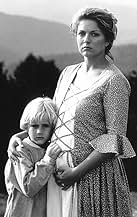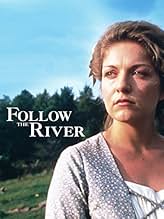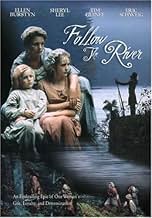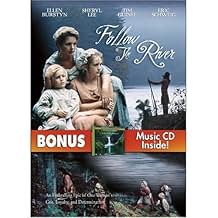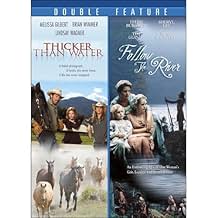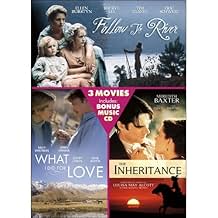Ajouter une intrigue dans votre langueAn "inspirational" true saga of a pioneer woman who is abducted by Shawnee Native Americans in 1755 and finds her way home after 10 years.An "inspirational" true saga of a pioneer woman who is abducted by Shawnee Native Americans in 1755 and finds her way home after 10 years.An "inspirational" true saga of a pioneer woman who is abducted by Shawnee Native Americans in 1755 and finds her way home after 10 years.
- Réalisation
- Scénario
- Casting principal
Andy Stahl
- Henry Lenard
- (as Andrew Stahl)
Stuart Proud Eagle Grant
- Gander Jack
- (non crédité)
Adrian Roberts
- Casper
- (non crédité)
Avis à la une
Follow The River was the best book I have ever read, and knowing it was a true story made it even more interesting. It has been about a year and a half since I read the book and I was quite excited to learn that the story had been made in to a movie. Even though the movie had been around since 1995 I didn't know it existed. The movie was quite a disappointment. From what I read in the book, Mary Ingles appeared to be a strong, passionate, brave and courageous woman. I don't understand why some of the events of the story were changed in the movie. There was no need for changes.Why didn't the script stick to the story just as it happened. It was a true life event---not a work of fiction. More time should have been given to her journey home. So much was left out. I don't think the acting was strong enough either. Maybe some day there will be a remake with actors that will fit the roles and it will be in the movie theaters so it will include many of the events that were left out and give more time to the journey back home.
I really enjoyed the movie. What is the saying? "If fate hands you lemons, make lemonade." Mary Ingles makes the best of her situation, but in the end decides it better to leave her children with the Shawnee and try and make it back to her husband many days travel away. That would be one tough decision. But then she is very STRONG. James Welch Henderson, Arkansas 2/21/2021
I submitted a review not long ago, but I don't think it was accepted because I had a lot of political commentary about not so politically correct stuff.
In 1985, when I was 14 years old, my mother came into my room and handed me a paperback book called FOLLOW THE RIVER. "This is the most INSPIRING story I've read in a long long time." I, not being much of a reader at that age, took this book, and COULD NOT PUT IT DOWN!!!
It is, to this day, my all time favorite novel. That they made a little TV movie based on this wonderful work was bad enough. They should have made an epic feature film about the unforgettable protag and her true story. But to make a TV movie that squishes 5 months in a woman's life into 2 commercial ridden hours, and sanitizes the facts too??? Foul!!!
Mary Draper Ingles was a young mother of three. Her third baby was actually due to be born any day. On July 8, 1755, Shawnee Native Americans raided her settlement in Virginia, killed many of her neighbors, and even killed her mother. Then they abducted her, her two little boys, her sister in law Bettie, and a neighbor named Lenard, and took them from Virginia, up into W. Virginia thru the New River Gorge, on to the mighty Ohio River, and into Southern Ohio (present site of Portsmouth). Mrs. Ingles' life is scattered, devastated and all but destroyed. Eventually, in a few weeks as a captive, she loses her family. Her sons are adopted and taken to still another faraway Shawnee settlement. Bettie is given as a wife to a Shawnee man, and Mary herself is sold to French traders, along with a new friend, Ghetel, an elderly Dutch widow. Her life further ruined and disrupted, she makes a fateful decision: either return home to Virginia and to her husband William, or life is not worth living. Will is all she has left to remind her of who she truly is. She must return to him.
The movie devotes a mere 20 mins. to Mary's 1000 mile walk home. The book is so much more fun to experience, so rich in detail, and author James A. Thom constantly lets you inside Mary's head to know her thoughts, fears, regrets. She decides she must abandon the baby girl she had en route to her slavery. A Shawnee woman has pretty much taken over the baby anyway.
In September 1755, Mary and the elderly Dutch woman Ghetel escape while on a salt making assignment at the Big Bone Lick in western Kentucky, even father from home than the town in Southern Ohio, and from western Kentucky, through Southern Ohio, through W. Va and the formidable New River Gorge, formed through the centuries into tall, dark, rocky palisades that Mary, who has been weakened, starved and fatigued by her travels already, is forced to CLIMB in order to reach her husband. On top of this, it is already wintertime.
None of these wonderous facts are in the movie. Instead, we are given a completely fictitious segment at the end. It just seems all watered-down, sanitized, politically correct. The ending of the movie is NOTHING AT ALL like the one in the book. Mary's two sons were taken from her. Her younger boy died right after he was taken from his mother. Thirteen years passed before Mary laid eyes on the older son again. The baby daughter was NOT BROUGHT BACK TO MARY BY CAPT. WILDCAT. The baby daughter was adopted by a Shawnee woman and never seen by her natural mother again. The ending of the TV movie was like a politically correct fairy tale.
Because of the depression, the emotional toll the events took on Mary Ingles' life, her hair turned prematurely white at the age of 23. But thankfully, she did return to her husband William, she did recover from her malnutrition, and she had four more children. In 1768, she and her oldest son, Thomas, who was 5 when she saw him last, were reunited after he was ransomed. Bettie Draper, who was given to be the wife/concubine of a Shawnee man, was also ransomed, but died at the young age of 42, doubtlessly having never fully recovered from her ordeal.
Fact: Life isn't fair. Bad things happen to good people. Things don't always end up well and fine. The history of this country is not a fairy tale.
In my opinion, if you're afraid of not being politically correct in telling the facts, don't make the movie.
In 1985, when I was 14 years old, my mother came into my room and handed me a paperback book called FOLLOW THE RIVER. "This is the most INSPIRING story I've read in a long long time." I, not being much of a reader at that age, took this book, and COULD NOT PUT IT DOWN!!!
It is, to this day, my all time favorite novel. That they made a little TV movie based on this wonderful work was bad enough. They should have made an epic feature film about the unforgettable protag and her true story. But to make a TV movie that squishes 5 months in a woman's life into 2 commercial ridden hours, and sanitizes the facts too??? Foul!!!
Mary Draper Ingles was a young mother of three. Her third baby was actually due to be born any day. On July 8, 1755, Shawnee Native Americans raided her settlement in Virginia, killed many of her neighbors, and even killed her mother. Then they abducted her, her two little boys, her sister in law Bettie, and a neighbor named Lenard, and took them from Virginia, up into W. Virginia thru the New River Gorge, on to the mighty Ohio River, and into Southern Ohio (present site of Portsmouth). Mrs. Ingles' life is scattered, devastated and all but destroyed. Eventually, in a few weeks as a captive, she loses her family. Her sons are adopted and taken to still another faraway Shawnee settlement. Bettie is given as a wife to a Shawnee man, and Mary herself is sold to French traders, along with a new friend, Ghetel, an elderly Dutch widow. Her life further ruined and disrupted, she makes a fateful decision: either return home to Virginia and to her husband William, or life is not worth living. Will is all she has left to remind her of who she truly is. She must return to him.
The movie devotes a mere 20 mins. to Mary's 1000 mile walk home. The book is so much more fun to experience, so rich in detail, and author James A. Thom constantly lets you inside Mary's head to know her thoughts, fears, regrets. She decides she must abandon the baby girl she had en route to her slavery. A Shawnee woman has pretty much taken over the baby anyway.
In September 1755, Mary and the elderly Dutch woman Ghetel escape while on a salt making assignment at the Big Bone Lick in western Kentucky, even father from home than the town in Southern Ohio, and from western Kentucky, through Southern Ohio, through W. Va and the formidable New River Gorge, formed through the centuries into tall, dark, rocky palisades that Mary, who has been weakened, starved and fatigued by her travels already, is forced to CLIMB in order to reach her husband. On top of this, it is already wintertime.
None of these wonderous facts are in the movie. Instead, we are given a completely fictitious segment at the end. It just seems all watered-down, sanitized, politically correct. The ending of the movie is NOTHING AT ALL like the one in the book. Mary's two sons were taken from her. Her younger boy died right after he was taken from his mother. Thirteen years passed before Mary laid eyes on the older son again. The baby daughter was NOT BROUGHT BACK TO MARY BY CAPT. WILDCAT. The baby daughter was adopted by a Shawnee woman and never seen by her natural mother again. The ending of the TV movie was like a politically correct fairy tale.
Because of the depression, the emotional toll the events took on Mary Ingles' life, her hair turned prematurely white at the age of 23. But thankfully, she did return to her husband William, she did recover from her malnutrition, and she had four more children. In 1768, she and her oldest son, Thomas, who was 5 when she saw him last, were reunited after he was ransomed. Bettie Draper, who was given to be the wife/concubine of a Shawnee man, was also ransomed, but died at the young age of 42, doubtlessly having never fully recovered from her ordeal.
Fact: Life isn't fair. Bad things happen to good people. Things don't always end up well and fine. The history of this country is not a fairy tale.
In my opinion, if you're afraid of not being politically correct in telling the facts, don't make the movie.
This movie was very pleasing and uplifting. It showed strength and courage. The women in their attempt to get home had to be brave. It also showed the Indian people to be merciful and with big hearts and a sense of humor. Their ways were different from the whites but still they knew that family is the most important thing there is in life.
James Alexander Thom writes novels that absolutely grip you with their intense realism, authentic settings and sometimes unexpectedly amusing content. His greatest work I believe is Panther in the Sky (a story of the Shawnee brothers Tecumseh and Tenkswatawa the Prophet). Don't miss it! Hopefully it will not be made into a movie as unfeeling as Follow the River.
This movie has the two returning women (on a 1000 mile journey) wearing clothes whose length would never permit them to travel through the woods, let alone do so without being torn to shreds. Everyone is portrayed as being forever clean, looking well-fed and with their hair always in place. The constantly changing relationship between the two women (as shown in the film) is obviously contrived and ultimately became very boring. An excellent adult book was made into a children's fantasy.
This movie has the two returning women (on a 1000 mile journey) wearing clothes whose length would never permit them to travel through the woods, let alone do so without being torn to shreds. Everyone is portrayed as being forever clean, looking well-fed and with their hair always in place. The constantly changing relationship between the two women (as shown in the film) is obviously contrived and ultimately became very boring. An excellent adult book was made into a children's fantasy.
Le saviez-vous
- AnecdotesBased on the Massacre at Draper Meadows July 8 1755.
- GaffesIn the scene in which Mary, Tommy and Betty are welcomed into the lodge with the Shawnee woman, Mary confides that she has little breastmilk for her newborn baby (likely due to malnutrition while in captivity). The woman gives her fennel seeds, which Mary then appears to feed directly to the baby. Seeds of any sort are never safe to feed to an infant. While fennel promotes lactation and eases colic, the best utilization is either the mother eating them or making a tea to give to the baby in very small doses.
Meilleurs choix
Connectez-vous pour évaluer et suivre la liste de favoris afin de recevoir des recommandations personnalisées
Détails
Contribuer à cette page
Suggérer une modification ou ajouter du contenu manquant

